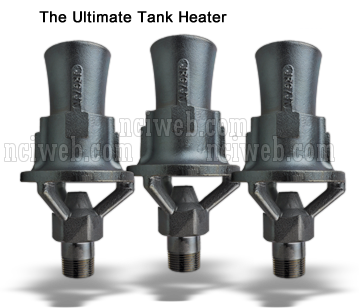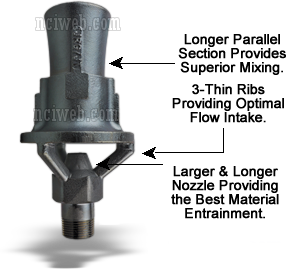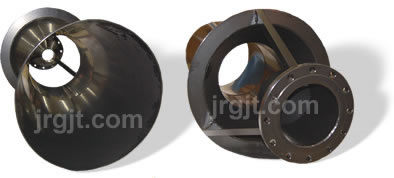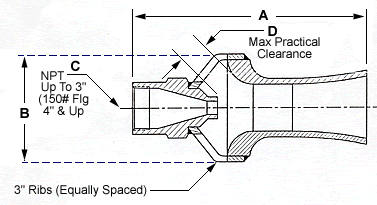Tank Heating Eductors (Sparger Nozzles)
 3 Web Body-Nozzle Provides Maximum Spacing for Superior Suction Flow
3 Web Body-Nozzle Provides Maximum Spacing for Superior Suction Flow- Superior Performance comes from a Superior Design - Up to 5 to 1 Entrainment.
- We have No-Equal!
Now Available with Edathon coating, the strongest of all the fluoropolymers!
Product Description
There are many advantages to using eductors for heating liquids in open vessels. These give the vessel heating eductor a place as a viable option for heating in many types of vessels.
The tank eductor heater provides direct contact of the steam into the liquid. This assures complete transfer of the energy in the steam into the liquid being heated. Other types of heating lose efficiency as the interior of the heat exchanger builds up a scale. With eductors, the velocity of the steam being injected into the vessel also causes the liquid contents of the vessel to be agitated while heating occurs, without the need for other types of mixers in the vessel. This provides for more even heating of the vessel contents. They also permit the steam to be dispersed over more of the liquid volume, resulting in a more homogenous heating than with other methods of injecting steam.
These designs of eductors allow steam to be used from 10 to 140 PSIG for heating. Because of the nature of direct steam injection, heating vessels at atmospheric pressure beyond 140° F should not be attempted. Exceeding this temperature could result in uncondensed steam evolving from the liquid.
 Computer optimized flow paths enable the Model TLM to maintain a high "pick-up ratio" (the ratio of fluid entrained to the motive fluid) while maximizing the hydraulic efficiency (the ratio of hydraulic power at the outlet of the TLM to the hydraulic power at the inlet) to generate an optimum flow field from the greatest flow amplification.
Computer optimized flow paths enable the Model TLM to maintain a high "pick-up ratio" (the ratio of fluid entrained to the motive fluid) while maximizing the hydraulic efficiency (the ratio of hydraulic power at the outlet of the TLM to the hydraulic power at the inlet) to generate an optimum flow field from the greatest flow amplification.
No moving parts in the sparger nozzle, minimizing maintenance expenses.
Optimum flow field enables more activity within the tank than competitive units without changing pumps.
Compact design and ease of mounting keeps the TLM from interfering with other tank equipment.
"In-tank" mounting eliminates need for costly, complex mounting structures above tanks.
The TLM can be used in a wide variety of open vessels or closed tanks.
Eliminates stratification and promotes a homogenous tank with relation to pH, temperature, solids or gas dispersion, and distribution of chemicals.
Produces a unique agitation not available with other types of mixers, as the TLM can generate a directed flow field within the fluid being mixed including viscous fluids, slurries, and suspensions.
Easily mixes liquids of differing specific gravities and is excellent for scrubbing applications where a lower specific gravity fluid is driven into the higher one.
Flow amplification due to high "pick-up ratio" and hydraulic efficiency permits the use of smaller pumps, which translates to reduced costs of mixing or agitation.
Reduces investment cost because existing transfer pumps can be utilized for more than one purpose.
 Excellent Corrosion Resistance
Excellent Corrosion Resistance - Excellent Abrasion Resistance
- 300° F Continuous Service
- Good Non-Stick Characteristics
- Excellent Dielectric Insulation
- Radiation Resistant
This coating is applied via electrostatic powder spray or fluidized powder bed. In addition to possessing the high chemical and temperature resistance which all fluoropolymers are noted for, Edathon's strengths, radiation resistance, wear resistance, and creep resistance are significantly greater than those of other fluoropolymers such as PTFE, FEP, or PFA.
 The standard models for heating in vessels are the TLM and ULJ. The model TLM is well suited to providing strong tank agitation while heating. Compared with other heaters, the cost per application is small. The model ULJ is designed to provide vigorous circulation of the liquid with low pressure steam inputs.
The standard models for heating in vessels are the TLM and ULJ. The model TLM is well suited to providing strong tank agitation while heating. Compared with other heaters, the cost per application is small. The model ULJ is designed to provide vigorous circulation of the liquid with low pressure steam inputs.
Sparger Nozzles should be located with the outlet pointed toward the most remote portion of the tank to provide the best agitation possible.
Simple, Economical and Reliable Tank Heating
The TLM tank eductor offers an inexpensive, yet highly effective way to improve circulation, agitation and heating of liquids in tanks.
Heating Liquids in Open Tanks
The TLM is an ejector-type jet, requiring no nipple, recommended for tanks in a multiple of installations.
Information needed to size includes the following:
What is the tank liquid? (If it is not water (Sg =1.0, Sh =1.0), contact us.)
What temperature rise (AT) is needed?
What is the final tank temperature?
What is the vessel capacity?
Time available to heat the vessel (t)?
Steam pressure available?
Step 1 To determine the amount of steam required to heat the liquid in the vessel, multiply the gallons in the vessel to be heated x 8.33 x Sg x Sh x temperature rise delta T desired, divided by 1100 (BTUs per Lb steam). Lb steam required (Wm) = Gal x 8.33 x Sg x Sh x delta T/1100
Step 2 To calculate the flow of steam required per minute, divide the steam flow from Step 1 by the time you need to complete the heating process. Lb steam per minute (Qm)= Wm/minutes (t)
Step 3 If multiple units are going to be used, divide the number from Step 2 by the number of units to be used.
Step 4 Go to the TLA Steam Flow table. Find the amount of steam flow Qm (Lb/Min) at the steam pressure available. This is the steam flow for a 1-1/2" unit. Take the steam flow obtained in Step 3 divided by the steam flow from the Steam Flow table. This will give the Sizing Factor (S.F.) needed to heat the vessel in the time required.
S.F. = Desired Steam Flowrate/ Saturated Steam Flowrate
Step 5 Choose the eductor size that has at meets or exceeds the number determined in Step 4
Example:
- The liquid in the vessel is Water (Sg =1.0)
The temperature rise desired is ?T = 50°F
The final tank temperature is 120°F
The vessel holds 550 gallons
The time to heat it is 20 minutes
Steam is available at 40 psig
Use two model TLAs
Step 1 Wm = 550 x 8.33 x 1.0 x 50/1100 = 208 Lb of steam required
Step 2 Qm = Lb steam per minute = 208/20 = 10.4 Lb steam per minute
Step 3 Are multiple units going to be used? If so how many? In this case, we will use two eductors. 10.4 Lb steam per minute/2 = 5.2 Lb/min per eductor
Step 4 S.F. = 5.2/13.4 = .39 desired S.F.
Step 5 Choose the model TLA 3/4" with a S.F. of .50 as this is the smallest unit that meets or exceeds the desired S.F.
Calculating Actual Performance
Qm per unit = 13.4 x.50 = 6.7 Lb/Min
Qm for installation = 6.7 x 2 =13.4 Lb/Min
Time to heat tank = 208 Lb (Step 1)/13.4 = 15.5 minutes
If two TLAs (3/4" size) are installed and operated at 40 psig of steam pressure, they will heat the liquid in 15.5 minutes.
-
TLM Steam Flow, Qm (lb/Min) 1-1/2" Unit 1020406080100120140Steam Flow, Qm (lb/Min)6.48.813.418.322.827.431.936.5
TLM Heater Performance Chart - Volume of Liquid Heated Per Minute, Qm (GPM)
| Size | ΔT* | 10 PSIG | 20 PSIG | 40 PSIG | 60 PSIG | 80 PSIG | 100 PSIG | 120 PSIG | 140 PSIG |
| 25 | 8.5 | 11.6 | 17.7 | 24.2 | 30.1 | 36.2 | 42.1 | 48.2 | |
| 50 | 4.2 | 5.8 | 8.8 | 12.1 | 15.1 | 18.1 | 21.1 | 24.1 | |
| 3/8" | 75 | 2.8 | 3.9 | 5.9 | 8.1 | 10.0 | 12.1 | 14.0 | 16.1 |
| 100 | 2.1 | 2.9 | 4.4 | 6.0 | 7.5 | 9.0 | 10.5 | 12.0 | |
| 125 | 1.7 | 2.3 | 3.5 | 4.8 | 6.0 | 7.2 | 8.4 | 9.6 | |
| 25 | 16.9 | 23.2 | 35.4 | 48.3 | 60.2 | 72.4 | 84.2 | 96.4 | |
| 50 | 8.5 | 11.6 | 17.7 | 24.2 | 30.1 | 36.2 | 42.1 | 48.2 | |
| 3/4" | 75 | 5.6 | 7.7 | 11,8 | 16.1 | 20.1 | 24.1 | 28.1 | 32.1 |
| 100 | 4.2 | 5.8 | 8.8 | 12.1 | 15.1 | 18.1 | 21.1 | 24.1 | |
| 125 | 3.4 | 4.6 | 7.1 | 9.7 | 12.0 | 14.5 | 16.8 | 19.3 | |
| 25 | 33.8 | 46.5 | 70.8 | 96.7 | 120.4 | 144.7 | 168.5 | 192.8 | |
| 50 | 16.9 | 23.2 | 35.4 | 48.3 | 60.2 | 72.4 | 84.2 | 96.4 | |
| 1-1/2" | 75 | 11.3 | 15.5 | 23.6 | 32.2 | 40.1 | 48.2 | 56.2 | 64.3 |
| 100 | 8.5 | 11.6 | 17.7 | 24.2 | 30.1 | 36.2 | 42.1 | 48.2 | |
| 125 | 6.8 | 9.3 | 14.2 | 19.3 | 24.1 | 28.9 | 33.7 | 38.6 | |
| 25 | 67.6 | 93.0 | 141.6 | 193.3 | 240.9 | 289.5 | 337.0 | 385.6 | |
| 50 | 33.8 | 46.5 | 70.8 | 96.7 | 120.4 | 144.7 | 168.5 | 192.8 | |
| 2" | 75 | 22.5 | 31.0 | 47.2 | 64.4 | 80.3 | 96.5 | 112.3 | 128.5 |
| 100 | 16.9 | 23.2 | 35.4 | 48.3 | 60.2 | 72.4 | 84.2 | 96.4 | |
| 125 | 13.5 | 18.6 | 28.3 | 38.7 | 48.2 | 57.9 | 67.4 | 77.1 | |
| 25 | 155.5 | 213.8 | 325.6 | 444.6 | 554.0 | 665.8 | 775.1 | 886.9 | |
| 50 | 77.8 | 106.9 | 162.8 | 222.3 | 277.0 | 332.9 | 387.5 | 443.4 | |
| 3" | 75 | 51.8 | 71.3 | 108.5 | 148.2 | 184.7 | 221.9 | 258.4 | 295.6 |
| 100 | 38.9 | 53.5 | 81.4 | 111.2 | 138.5 | 166.4 | 193.8 | 221.7 | |
| 125 | 31.1 | 42.8 | 65.1 | 88.9 | 110.8 | 133.2 | 155.0 | 177.4 | |
| 4" ** | Contact Us for Data On Units Over 4" | ||||||||
Tank Eductor Dimensions:
 |
 |
| Size | Dimension A | Dimension B | Dimension C | Dimension D | ||||
| IN | (mm) | IN | (mm) | IPS | (mm) | IN | (mm) | |
| 3/8" | 5.00 | (127) | 2.50 | (64) | 3/8 MNPT | (10) | .50 | (12) |
| 3/4" | 7.25 | (184) | 3.69 | (94) | 3/4 MNPT | (20) | .81 | (20) |
| 1-1/2" | 10.88 | (276) | 5.50 | (140) | 1-1/2 FNPT | (40) | 1.12 | (28) |
| 2" | 14.50 | (368) | 7.69 | (195) | 2 FNPT | (50) | 1.62 | (41) |
| 3" | 22.00 | (559) | 11.75 | (298) | 3 FNPT | (80) | 2.50 | (63) |
| 4" | 25.00 | (635) | 12.00 | (305) | 4 FNPT | (100) | 3.00 | (76) |
| 6" | 35.00 | (889) | 25.00 | (635) | 6 FNPT | (150) | 4.50 | (114) |
| 8" | Contact Us for Data On Units Over 8 " | |||||||
